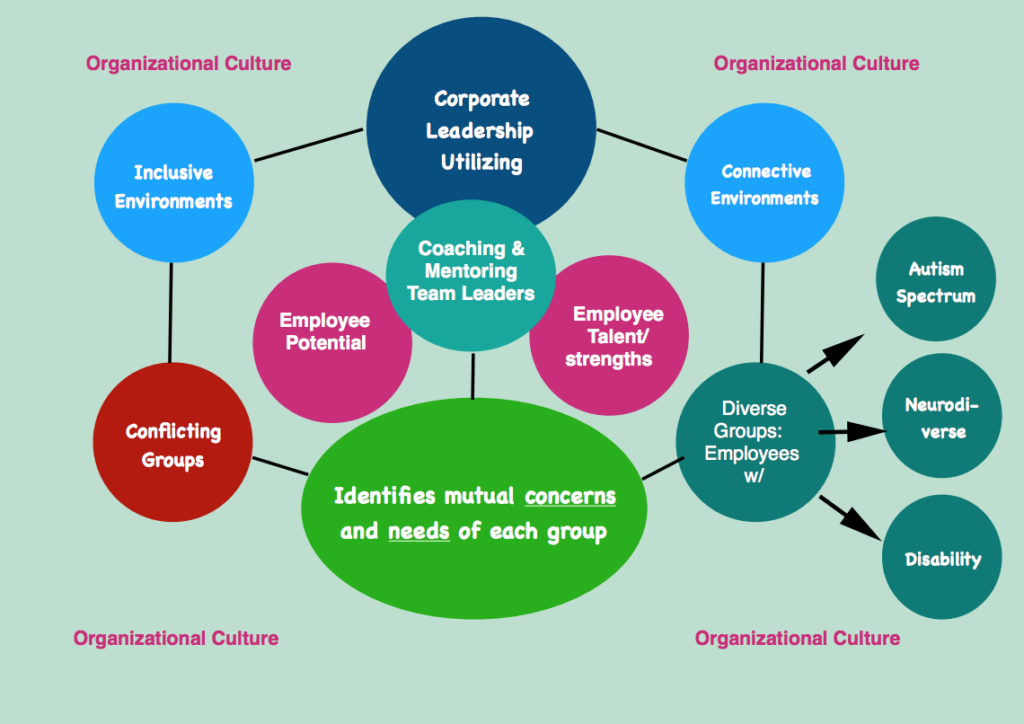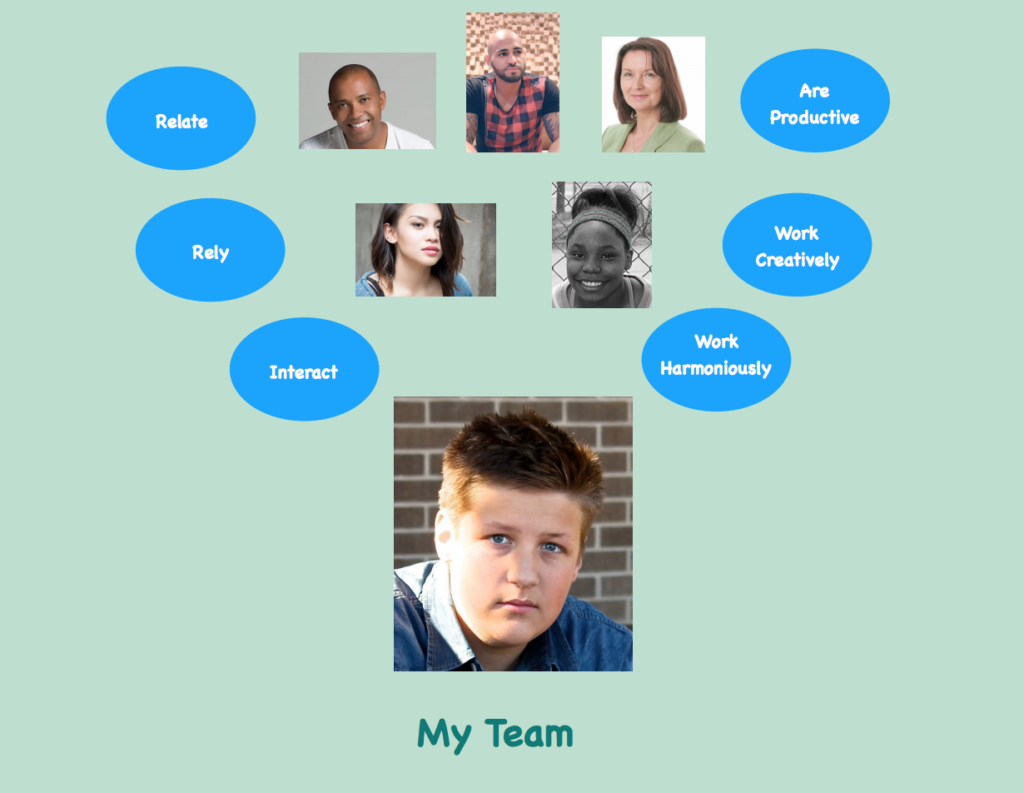
Changing the Employment Landscape for Individuals on the Autism Spectrum
By Jackie M. Marquette, Ph.D.
After high school days ended for Trent, my autistic son, the change was abrupt and difficult. Leaving a marriage, we moved into a house next door to my mother for support. One evening after dinner at a restaurant, Trent grabbed folded napkins on a table near the front door and anxiously began rearranging them. Unable to follow us out, he obsessed. After 5 minutes, I was worried because he was in the way of new customers coming in. The manager asked me if he could help. He had a kind gentle manner about him, which I trusted. I told him that my son had autism and I wanted his assistance. Together we held Trent’s arms and gently walked him out the door. I was relieved to have help and thanked the manager.
The situation at that time was an example of Trent’s daily life at home and out in the community. Moving out of his childhood home and then facing his transition of sitting at home with nothing to do, was devastating to him. I was disheartened. He relied upon me and others to create a satisfying work life connected to his interests and strengths. Building that life took time. His obsessive behavior lasted for two years before it diminished. I deeply know all too well the desperation of high school transition for young adults with autism and their families.
With an employment agency’s support, in 2003 Trent was hired to work at Meijer, INC., a large discount retail store. He had the job for 13 years, starting in the Lawn and Garden department and eventually working in other departments with team collaboration. An innovative employment model of teams worked well for Trent because the team approach used his best strengths and interests. Yet with his limitations, team members covered the tasks he could not do. See my CIE MODEL INFOGRAPHIC (Trent’s actual employment experiences at Meijer is represented through ‘John’ in the infographic).
Today Trent is 40 years old and enjoys his true life using his natural artistic talents. For the past 16 years he has been a professional abstract artist, and in 2012 became an award winning United Nations artist.
An Employment Model that Works
For the past 3 decades, I taught and provided career guidance to youth and young adults. For the last 15 years, my research focused on autism, employment, and their adaptations. My research participants included young adults and their parents or advocates, who had the courage to share their stories and experiences in how they found meaning in their lives. Because of them, I learned what my clients needed to prepare for career goals and forged a path that defined my career and life
I have a vision of one day walking through companies and organizations and noticing a variety of employees, including those who identify themselves as diverse, neurodiverse, autistic or other disability. They hold careers or jobs using talents, reaching potential, working on teams, and being appreciated for their unique abilities.
In an effort to understand the types of environments that best meet the needs of a variety of employees, my personal experiences and research have led me to propose a Connective Interdependent Employment (CIE) model. The CIE provides an advantage to support companies in creating inclusive connective cultures for hiring employees with talent and abilities. The CIE is considered to be the most effective model to creating an inclusive corporate culture.
CIE is an inclusive model that connects employees to one another to collaborate on teams. Each employee is valued as a team member contributing their skills or tasks to the team or the project.
The CIE culture includes interdependence:
- Interdependence is defined as: a mutual reliance of individuals on one another. In the context of the work environment,each employee’s contribution can enhance the outcomes of the group effort and the whole environment of the creative employment structure.
- It ensures that everyone understands what needs to be done and why.
- It supports positive business change since teamwork creates strong cooperation (i.e. synergy).
CIE begins with leadership direction.
Leaders who exemplify the CIE model have “connective leadership behaviors” that promote team collaboration and organizational change in the following ways:
- working with teams to identify specific areas of changes and company goals,
- coaching and mentoring employees on CIE culture, and
- rewarding team accomplishments.
All individuals have a major impact on creating a connected culture
The key participants in the company share in the goals, responsibilities and success of the company as “stakeholders”. A stakeholder is one that has a stake in a specific enterprise, corporation or place of business.
I see the innovative path of a corporation to hire individuals with disabilities as something that needs to be supported by all stakeholders. Stakeholders can affect or be affected by the organization’s actions, objectives and policies. Key stakeholders in the CIE include: employees with autism/disability, allies (schools, employment agencies, disability associations, Office of Vocational Rehabilitation), CEO/Owners, shareholders, suppliers, unions, managers, team leaders, and team members.
Companies need qualified candidates to fill positions. Two of the stakeholders in category of ‘Allies’ include schools and employment agencies.
Preparing youth during school for jobs and careers is the first important step. Career readiness programs prepare students to transition to a job, receive training/college degrees, and access to employment agencies that provide job development with job coaches.
In particular to schools, The Council of Chief State School Officers indicates our education system is currently not keeping up with the goal of getting students “college and career ready”.
In my experience, I find that many schools have missed providing the educational activities that would benefit the autistic student in their career readiness. Activities left out of school transition programs include: 1) assessing multiple areas of strength for the individual student with respect to academic, artistic, self awareness, and personal preferences; 2) teaching self awareness through activities for on-the-job effectiveness; 3) providing exposure to careers and exploration activities in the community, such as job try-outs, job shadowing, volunteering and interviewing key people.
School Career readiness programs should offer students:
- assessments to better understand their strengths and talents.
- opportunities for exposure to take part in career exploration in the community.
- ways to use tools to reduce anxiety and increase follow-through on tasks. Students with autism may especially benefit from tools to create predictability and safe exposure to a new setting with unfamiliar people.
- safe exposure to create positive experiences. Safe exposure to settings enhances learning, emotional adaptation, and on-the-job capabilities.
- unique ways to respond to positive or abrupt change on the job.
- support to develop self-awareness of one’s strengths, emotions, and challenges.
Give this FREE strength awareness questionnaire to yourself or someone you know.
Employment agencies
Employment agencies play a significant role in assisting individuals with autism or other disabilities in getting hired. A job coach negotiates and advocates for the hire of their client. The objective is to find the best job fit that matches the client’s abilities, strengths, and skills. Therefore, it is very important that job coaches have access to all essential information that schools provide in their career readiness programs about individual’s abilities and strengths. For example, if their client has a challenge such as, giving direct eye contact, this might be considered as critical information to the employer.
Connections by other interested people may have contacts to open opportunities for an individual’s hire to a company. These people may include a parent, relative, friend or association in the place of employment, club, or church.
Evaluating Abilities and Strengths
It is essential to highlight an individual’s attributes, characteristics for potential, and limitations in order to get hired for the best job fit and have the ability to keep the job on a long-term basis. Assessments must include these broad areas: a) academics/cognitive, b) self expression through multiple intelligence, c) personal preferences, and d) self awareness. The findings can be directly tied to solutions for on-the-job capabilities and making adaptations.
One example I’d like to give, is from an individual we will call Roger. Roger has a talent and interest in video editing.
Academics/Cognitive: Roger is hired for a project with a foundation. He is supposed to report to a committee about his progression through a video editing project. He discovered through the strengths and career assessment that he has a challenge in writing and verbally presenting the information to a committee. One way to overcome this challenge may be to explore the option to ask a coworker to join Roger, both in preparation and presenting. Thus, together they write a list of items to reveal his progress and necessary steps to complete the project. This is about Roger and others’ understanding and acceptance of his strengths and challenges.
Multiple Intelligence: Roger has keen creativity to choose the right music for the videos he edits. His employer and project committee love the final project using his talent to focus on the intent and emotion of the video. Roger’s talent is appreciated and valued in the foundation.
Personal Preferences
Roger discovered through the strengths and career assessment that he doesn’t work well under time constraints and pressure. His boss liked his initial video edits but wants the project completed with minor edits in 1 hour and 30 minutes. Roger became highly anxious. He didn’t share with the boss when first hired that he doesn’t work well under time pressure. Although Roger’s boss may not have liked his answer, Roger could learn to respond by saying, “I will do my best.” and then learn to let it go. This helps Roger understand himself and accept his challenges. The boss may see his value overall and accept his limitation when expected to perform in a short time frame.
Self Awareness
Roger suffers much stress in interactions with other people, especially when he is expected to give direct eye contact. Roger has learned to disclose the limitation. If he wasn’t aware of the importance of giving eye contact during an interaction, he may frustrate his boss and coworkers. Worse, he may have eventually lost his job because others may have perceived him as rude or anti-social. It is best that Roger communicate to the people who hired him that he understands interactions best when he doesn’t have to give eye contact.
When everyone understands Roger’s limitation, he may be accepted.
Based on the description of the CIE model and the example of Roger in the workplace, a few key aspects are noticeable. Evidently, the CIE model promotes a culture of diversity, inclusion and acceptance. Companies win when hiring and utilizing the potential of all employees including individuals who are neurodiverse, on the autism spectrum or have other disabilities. In addition, Business leaders have been shown to agree that hiring and retaining people with disabilities can build a more authentic, loyal and creative culture.
With the CIE team model employees have the freedom and support to take part in company change, project implementation, and problem solving in a timely and accurate manner. These characteristics provide a collaborative environment for employees to work together and to see how their efforts impact others. At the same time, job satisfaction among employees and managers is enhanced.
The purpose of my writing this article is to hope the reader will be inspired to walk away with real steps to move forward. If you are a young adult with autism or disability in high school or college, I hope you will want to learn more about your strengths and their strong connection to building a satisfying career. As an employment agency with job coaches, I hope you see there are many more pieces to use in job development. Without knowledge of all combined areas, job development becomes a guessing game. If you are parents or a family member of someone with autism, realize that the preparation for careers begins at home. Find ways to inspire your loved one’s development of skills, talent, and self emotional awareness. These are all necessary in order to get a job and to keep the job. My hopes for school personnel is to see career readiness as one of the highest program priorities to offer students because it can have a direct benefit to getting students employed. When each student in special education and even regular education tracks graduates knowing their strengths that match careers, personal preferences to self manage, engaging practice in self awareness development, on-site exposure and career exploration, they are more prepared to enter the workforce. Lastly, my hope is that business leaders see the value that people with autism and other disabilities have when matched to jobs they can do and connected to teams whereby coworkers value each members abilities and contributions.
Jackie Marquette Ph.D. is dedicated to bringing innovative and unique solution based career tools and leadership to organizations and individuals with ASD and diverse challenges. Dr. Jackie provides consultation, writes, and conducts her own research. She has a son with autism in his 30s who is an accomplished award winning artist. Visit:
www.marquettestrengthsindex.com







